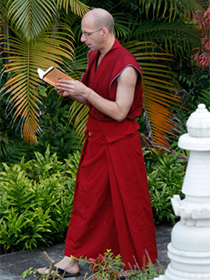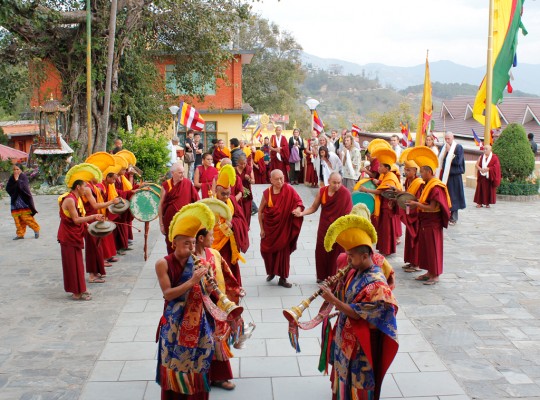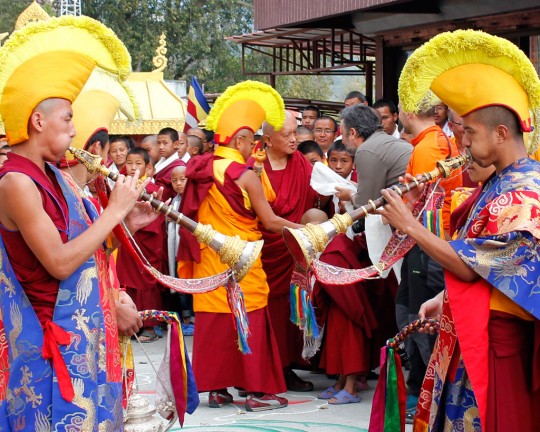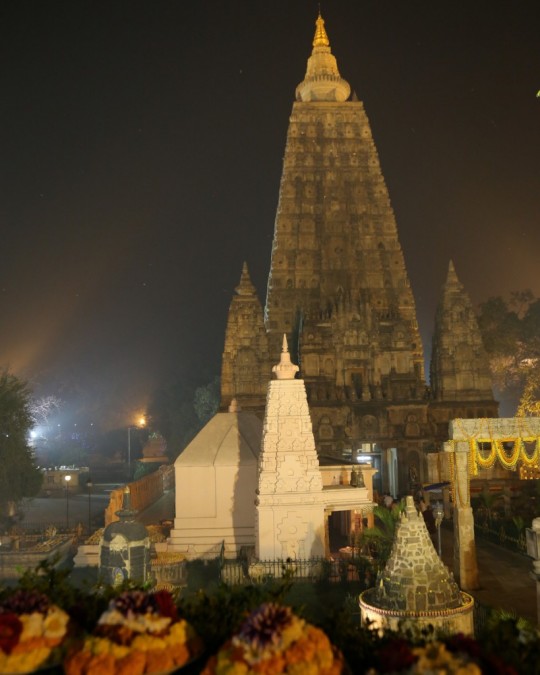- Home
- FPMT Homepage
Foundation for the Preservation of the Mahayana Tradition
The FPMT is an organization devoted to preserving and spreading Mahayana Buddhism worldwide by creating opportunities to listen, reflect, meditate, practice and actualize the unmistaken teachings of the Buddha and based on that experience spreading the Dharma to sentient beings. We provide integrated education through which people’s minds and hearts can be transformed into their highest potential for the benefit of others, inspired by an attitude of universal responsibility and service. We are committed to creating harmonious environments and helping all beings develop their full potential of infinite wisdom and compassion. Our organization is based on the Buddhist tradition of Lama Tsongkhapa of Tibet as taught to us by our founders Lama Thubten Yeshe and Lama Thubten Zopa Rinpoche.
- Willkommen
Die Stiftung zur Erhaltung der Mahayana Tradition (FPMT) ist eine Organisation, die sich weltweit für die Erhaltung und Verbreitung des Mahayana-Buddhismus einsetzt, indem sie Möglichkeiten schafft, den makellosen Lehren des Buddha zuzuhören, über sie zur reflektieren und zu meditieren und auf der Grundlage dieser Erfahrung das Dharma unter den Lebewesen zu verbreiten.
Wir bieten integrierte Schulungswege an, durch denen der Geist und das Herz der Menschen in ihr höchstes Potential verwandelt werden zum Wohl der anderen – inspiriert durch eine Haltung der universellen Verantwortung und dem Wunsch zu dienen. Wir haben uns verpflichtet, harmonische Umgebungen zu schaffen und allen Wesen zu helfen, ihr volles Potenzial unendlicher Weisheit und grenzenlosen Mitgefühls zu verwirklichen.
Unsere Organisation basiert auf der buddhistischen Tradition von Lama Tsongkhapa von Tibet, so wie sie uns von unseren Gründern Lama Thubten Yeshe und Lama Thubten Zopa Rinpoche gelehrt wird.
- Bienvenidos
La Fundación para la preservación de la tradición Mahayana (FPMT) es una organización que se dedica a preservar y difundir el budismo Mahayana en todo el mundo, creando oportunidades para escuchar, reflexionar, meditar, practicar y actualizar las enseñanzas inconfundibles de Buda y en base a esa experiencia difundir el Dharma a los seres.
Proporcionamos una educación integrada a través de la cual las mentes y los corazones de las personas se pueden transformar en su mayor potencial para el beneficio de los demás, inspirados por una actitud de responsabilidad y servicio universales. Estamos comprometidos a crear ambientes armoniosos y ayudar a todos los seres a desarrollar todo su potencial de infinita sabiduría y compasión.
Nuestra organización se basa en la tradición budista de Lama Tsongkhapa del Tíbet como nos lo enseñaron nuestros fundadores Lama Thubten Yeshe y Lama Zopa Rinpoche.
A continuación puede ver una lista de los centros y sus páginas web en su lengua preferida.
- Bienvenue
L’organisation de la FPMT a pour vocation la préservation et la diffusion du bouddhisme du mahayana dans le monde entier. Elle offre l’opportunité d’écouter, de réfléchir, de méditer, de pratiquer et de réaliser les enseignements excellents du Bouddha, pour ensuite transmettre le Dharma à tous les êtres. Nous proposons une formation intégrée grâce à laquelle le cœur et l’esprit de chacun peuvent accomplir leur potentiel le plus élevé pour le bien d’autrui, inspirés par le sens du service et une responsabilité universelle. Nous nous engageons à créer un environnement harmonieux et à aider tous les êtres à épanouir leur potentiel illimité de compassion et de sagesse. Notre organisation s’appuie sur la tradition guéloukpa de Lama Tsongkhapa du Tibet, telle qu’elle a été enseignée par nos fondateurs Lama Thoubtèn Yéshé et Lama Zopa Rinpoché.
Visitez le site de notre Editions Mahayana pour les traductions, conseils et nouvelles du Bureau international en français.
Voici une liste de centres et de leurs sites dans votre langue préférée
- Benvenuto
L’FPMT è un organizzazione il cui scopo è preservare e diffondere il Buddhismo Mahayana nel mondo, creando occasioni di ascolto, riflessione, meditazione e pratica dei perfetti insegnamenti del Buddha, al fine di attualizzare e diffondere il Dharma fra tutti gli esseri senzienti.
Offriamo un’educazione integrata, che può trasformare la mente e i cuori delle persone nel loro massimo potenziale, per il beneficio di tutti gli esseri, ispirati da un’attitudine di responsabilità universale e di servizio.
Il nostro obiettivo è quello di creare contesti armoniosi e aiutare tutti gli esseri a sviluppare in modo completo le proprie potenzialità di infinita saggezza e compassione.
La nostra organizzazione si basa sulla tradizione buddhista di Lama Tsongkhapa del Tibet, così come ci è stata insegnata dai nostri fondatori Lama Thubten Yeshe e Lama Zopa Rinpoche.
Di seguito potete trovare un elenco dei centri e dei loro siti nella lingua da voi prescelta.
- 欢迎 / 歡迎
简体中文
“护持大乘法脉基金会”( 英文简称:FPMT。全名:Foundation for the Preservation of the Mahayana Tradition) 是一个致力于护持和弘扬大乘佛法的国际佛教组织。我们提供听闻,思维,禅修,修行和实证佛陀无误教法的机会,以便让一切众生都能够享受佛法的指引和滋润。
我们全力创造和谐融洽的环境, 为人们提供解行并重的完整佛法教育,以便启发内在的环宇悲心及责任心,并开发内心所蕴藏的巨大潜能 — 无限的智慧与悲心 — 以便利益和服务一切有情。
FPMT的创办人是图腾耶喜喇嘛和喇嘛梭巴仁波切。我们所修习的是由两位上师所教导的,西藏喀巴大师的佛法传承。
繁體中文
護持大乘法脈基金會”( 英文簡稱:FPMT。全名:Found
ation for the Preservation of the Mahayana Tradition ) 是一個致力於護持和弘揚大乘佛法的國際佛教組織。我們提供聽聞, 思維,禪修,修行和實證佛陀無誤教法的機會,以便讓一切眾生都能 夠享受佛法的指引和滋潤。 我們全力創造和諧融洽的環境,
為人們提供解行並重的完整佛法教育,以便啟發內在的環宇悲心及責 任心,並開發內心所蘊藏的巨大潛能 — 無限的智慧與悲心 – – 以便利益和服務一切有情。 FPMT的創辦人是圖騰耶喜喇嘛和喇嘛梭巴仁波切。
我們所修習的是由兩位上師所教導的,西藏喀巴大師的佛法傳承。 察看道场信息:
- FPMT Homepage
- News/Media
-
- Study & Practice
-
-
- About FPMT Education Services
- Latest News
- Programs
- New to Buddhism?
- Buddhist Mind Science: Activating Your Potential
- Heart Advice for Death and Dying
- Discovering Buddhism
- Living in the Path
- Exploring Buddhism
- FPMT Basic Program
- FPMT Masters Program
- FPMT In-Depth Meditation Training
- Maitripa College
- Lotsawa Rinchen Zangpo Translator Program
- Universal Education for Compassion & Wisdom
- Online Learning Center
-
- Prayers & Practice Materials
- Overview of Prayers & Practices
- Full Catalogue of Prayers & Practice Materials
- Explore Popular Topics
- Benefiting Animals
- Chenrezig Resources
- Death & Dying Resources
- Lama Chopa (Guru Puja)
- Lama Zopa Rinpoche: Compendium of Precious Instructions
- Lama Zopa Rinpoche: Life Practice Advice
- Lama Zopa Rinpoche Practice Series
- Lamrim Resources
- Mantras
- Prayer Book Updates
- Purification Practices
- Sutras
- Thought Transformation (Lojong)
- Audio Materials
- Dharma Dates - Tibetan Calendar
- Translation Services
- Publishing Services
- Ways to Offer Support
- Prayers & Practice Materials
-
- Teachings and Advice
- Find Teachings and Advice
- Lama Zopa Rinpoche Advice Page
- Lama Zopa Rinpoche: Compendium of Precious Instructions
- Lama Zopa Rinpoche Video Teachings
- ༧སྐྱབས་རྗེ་བཟོད་པ་རིན་པོ་ཆེ་མཆོག་ནས་སྩལ་བའི་བཀའ་སློབ་བརྙན་འཕྲིན།
- Podcasts
- Lama Yeshe Wisdom Archive
- Buddhism FAQ
- Dharma for Young People
- Resources on Holy Objects
- Teachings and Advice
-
-
*If a menu item has a submenu clicking once will expand the menu clicking twice will open the page.
-
-
- Centers
-
- Teachers
-
- Projects
-
-
-
-
*If a menu item has a submenu clicking once will expand the menu clicking twice will open the page.
-
-
- FPMT
-
-
-
-
-
However the very bottom line is to do all ones actions with bodhichitta. That is the best, the most meaningful way to think during your break time. This makes your life most beneficial. As much as possible with awareness keep ones attitude and thoughts in bodhichitta, the thought of benefiting others, try to do all the activities with that mind, including doing your job and throughout the day. This way even in your break time whatever you do becomes the cause of happiness.
Lama Zopa Rinpoche
-
-
-
- Shop
-
-
-
The Foundation Store is FPMT’s online shop and features a vast selection of Buddhist study and practice materials written or recommended by our lineage gurus. These items include homestudy programs, prayers and practices in PDF or eBook format, materials for children, and other resources to support practitioners.
Items displayed in the shop are made available for Dharma practice and educational purposes, and never for the purpose of profiting from their sale. Please read FPMT Foundation Store Policy Regarding Dharma Items for more information.
-
-
Lama Zopa Rinpoche News and Advice
16
Lawudo Family Reunion
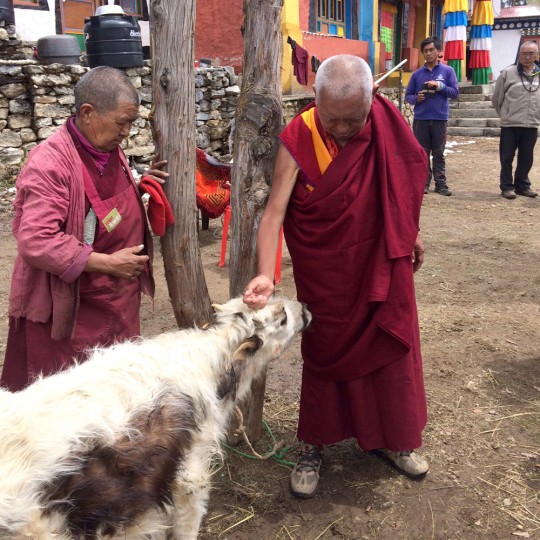
Lama Zopa Rinpoche with his sister, Ani Samten, blessing a Lawudo cow. Rinpoche’s brother Sangay Sherpa looks on in the background, Lawudo Gompa and Retreat Centre, Solu Khumbu, Nepal, April 2015. Photo by Harry Sutton.
Lama Zopa Rinpoche’s current visit to Lawudo Gompa and Retreat Centre in Solu Khumbu, Nepal, is special for many reasons. Lawudo cave was the meditation cave of Rinpoche’s previous incarnation Kunsang Yeshe, more commonly known as the Lawudo Lama. Rinpoche was born not far from Lawudo and has a close affinity with the Sherpa people in the area. But also, Rinpoche’s sister and brother are integral to Lawudo’s continued existence and they are all together during Rinpoche’s visit.
Ani Ngawang Samten, Rinpoche’s older sister, has overseen all of the development at Lawudo and has taken care of the students, teachers and retreaters who have visited Lawudo since the early days of FPMT. Back then, she carried stones and helped build the gompa at Lawudo. And for four decades, she has cooked the food and made sure that visitors have what they need. Ven. Roger Kunsang, CEO of FPMT and Rinpoche’s assistant, has called her the “mother” of Lawudo.
Anila also lovingly takes care of the cows. One day during Rinpoche’s visit, he went to the dining room at breakfast and talked to all gathered there about the benefits of not killing and of a vegetarian diet. Then Rinpoche went out and blessed all of the cows until lunch time.
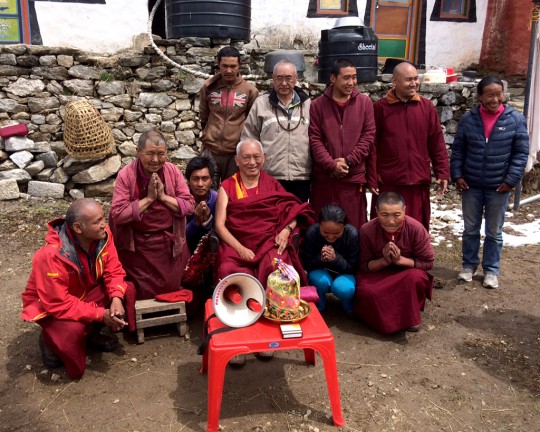
Lama Zopa Rinpoche with his sister Ani Ngawang Samten (kneeling to the left of Rinpoche) and his brother Sangay Sherpa (in the tan jacket behind Rinpoche) along with other Sherpas at Lawudo, Solu Khumbu, Nepal, April 2015. Photo by Harry Sutton.
Rinpoche’s brother, Sangay Sherpa, serves as the director of Lawudo and has been responsible for the recent building work, which includes building a new library and restoring the old gompa. The harsh environment and high altitude create many challenges for construction. Materials must be flown in from Kathmandu to Lukla by plane or to Syangboche by helicopter and then brought up to Lawudo on the backs of yaks and Sherpa porters.
Rinpoche’s visit to Lawudo is truly a homecoming and a rare opportunity for a reunion with his family, who continue to quietly keep the fires burning at this very special place.
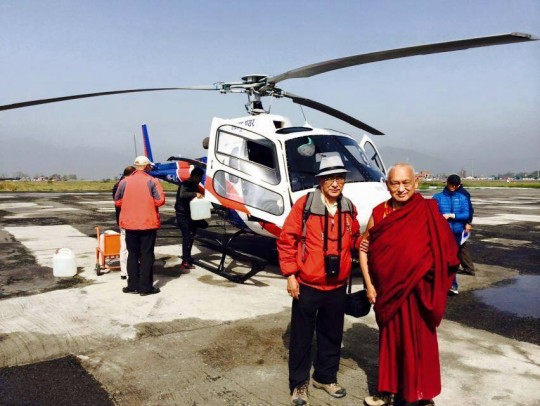
Lama Zopa Rinpoche and his brother Sangay Sherpa at the Kathmandu airport before flying up to Lawudo, Nepal, April 2015. Photo by Ven. Lobsang Sherab.
Anila’s amazing contributions and work at Lawudo have been celebrated and described by Merry Colony, long-time student and former director of FPMT Education Services, in the Mandala January-February 1998 article, “The Keeper of Lawudo.”
Lama Zopa Rinpoche is the spiritual director of the Foundation for the Preservation of Mahayana Tradition (FPMT), a Tibetan Buddhist organization dedicated to the transmission of the Mahayana Buddhist tradition and values worldwide through teaching, meditation and community service.
- Tagged: ani ngawang samten, fpmt history, lama zopa rinpoche, lawudo, sangay sherpa
- 0
15
Practice Awareness of Karma When You Walk Outside

Lama Zopa Rinpoche, Root Institute, Bodhgaya, India, March 2015. Photo by Ven. Thubten Kunsang.
“When you are working outside and see a beautiful flower that pleases you, that is your karmic view,” said Lama Zopa Rinpoche during the 16th Kopan course in 1983. “That view comes from your own mind, from virtuous thoughts. Anything which is disagreeable and disturbing to you is the result of bad thoughts in the past – negative karma. Whenever you experience sense objects – good smells, bad smells, when eating food, when looking around at views, practice awareness. When you see people or animals: when you see one person it makes you happy, another makes you unhappy. If one person is helping you, think, ‘This is the result of my good karma, of having the right attitude.’ If somebody makes you unhappy, think, ‘This is the result of my negative karma, the bad thoughts.’ It is so obvious, so clear, how liking or not liking, seeing something as nice or not nice, is dependent on your mind. When some people look at a particular person, they find him so nice, beautiful, good and so on; at the same time when others look at him they find him completely ugly, not worth being attached to! They see the one person in different ways.
“Let’s say you’re in prison and somebody unknown helps you get free. You see that person afterwards but you don’t see him as kind, you don’t have a warm feeling; but when you hear that he is the one that helped when you had troubles, suddenly you see him in a different way. You see him as having a warm beauty, as kind. For your mind, the person becomes nearer. Similarly, when a person is disturbing you, you see him as ugly, very bad, negative, black; but if you think of his kindness in destroying your selfish attitude, your bad thoughts, the view changes. He becomes closer and you feel warmth and kindness from the heart. Now you can see how it’s dependent on the mind. When you change your way of thinking, you will see things in a different way. With one way of thinking you see in one way, with another way of thinking you see in a different way. Some people see one place as very beautiful and like it, some see it as very ugly and undesirable.
“Like this, practice awareness of karma when you walk outside. When pleasure turns into suffering think that is the result of wrong attitudes, of negative karma. Also, you can maybe do meditations on all your past lives. Sometimes you had a good life, sometimes a horrible, terrifying, suffocating life, wanting to kill yourself. Then think, ‘All this came from the wrong attitude in my own mind.’
“We should use this awareness for something, for progressing the mind. We should use this awareness for more happiness, to decrease suffering, to lessen confusion. So, make the decision frequently, ‘This is the result of right attitudes. Therefore, what I should do from now on is renounce the non-virtuous mind as much as possible and practice the right attitude, a good heart, as much as possible.'”
Excerpted from the transcripts of Lecture 3 of the 16th Kopan course (http://bit.ly/16th-kopan-course) made available by the Lama Yeshe Wisdom Archive. Edited by Mandala for inclusion on FPMT.org.
Learn more about Lama Zopa Rinpoche, spiritual director of the Foundation for the Preservation of Mahayana Tradition (FPMT), and Rinpoche’s vision for a better world. Sign up to receive news and updates.
14
An Easy Way to Benefit Animals
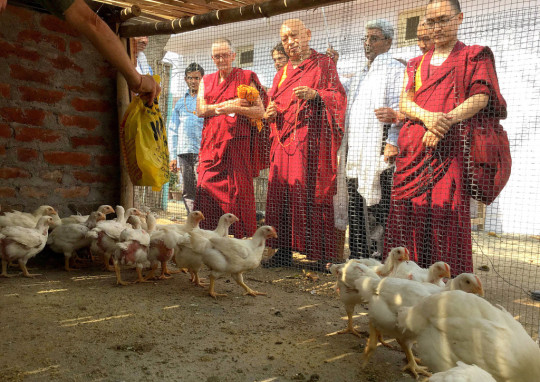
Lama Zopa Rinpoche spent time blessing the chickens at Root Institute, Bodhgaya, India, March 2015. Photo by Ven. Sarah Thresher.
“When Lama Zopa Rinpoche was traveling from Gaya airport to Root Institute on the day of his arrival in early February 2015, he noticed the roadside shops that sell live chickens,” said long-time student Ven. Sarah Thresher. “The chickens are crammed into small wire cages and sold to customers by the weight, either alive, or beheaded and ready to be eaten. Rinpoche immediately expressed his wish to liberate the chickens and gave instructions for a large coop to be built so they could wander around freely, but still be prevented from eating other creatures. While the coop was being constructed, Rinpoche wrote out by hand the Lotus Pinnacle of Amoghaspasha mantra (FPMT Education Services’ makes available a brief commentary on the mantra by Geshe Ngawang Dakpa; a pre-printed version with a short commentary by Lama Zopa Rinpoche is available through the Foundation Store) to be photocopied and pasted inside, covering the entire ceiling. The Namgyälma mantra was also included so that the birds would constantly purify their negative karma day and night. Lotus Pinnacle of Amoghaspasha mantra – OM PÄDMO USHNISHA VIMALE HUM PHAT – is usually hung over doorways and purifies eight trillion eons of negative karma by passing under it. By placing the Namgyälma mantra in a high place or in a room, it also purifies and blesses the people, animals or insects in that area, liberating them from the lower realms. Rinpoche has spoken extensively the Namgyälma mantra’s benefits.
“Over the course of the two months spent at Root, Rinpoche liberated 62 chickens and blessed all the animals – goats, cows, chickens, dogs, etc. – at Root and nearby MAITRI Charitable Trust by reciting prayers and mantras. Not just the chicken coop, but also the cow shed ceiling were covered with Lotus Pinnacle of Amoghapasha and Namgyälma mantras – such an easy way to benefit animals!”
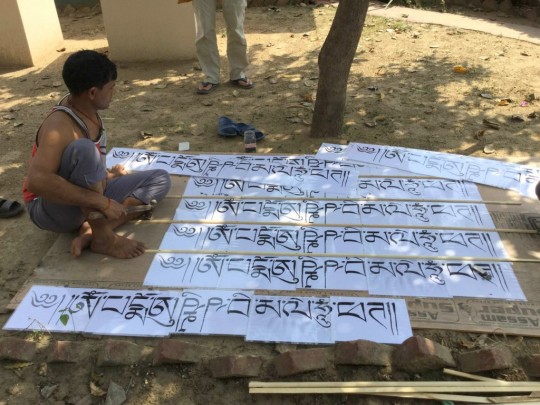
Mantras line the roof of the chicken coop at Root Institute, Bodhgaya, India, March 2015. Photo by Ven. Sarah Thresher.
Benefiting animals in any way possible is a priority for FPMT and one of Lama Zopa Rinpoche’s Vast Visions for the organization. Both the Lama Zopa Rinpoche Bodhichitta Fund and the Animal Liberation Fund support animal liberation activities around the world.
FPMT Education Services makes a variety of mantra-related resources available on FPMT.org.
Learn more about Lama Zopa Rinpoche, spiritual director of the Foundation for the Preservation of Mahayana Tradition (FPMT), and Rinpoche’s vision for a better world. Sign up to receive news and updates.
13
A Hundred Eons Is Nothing
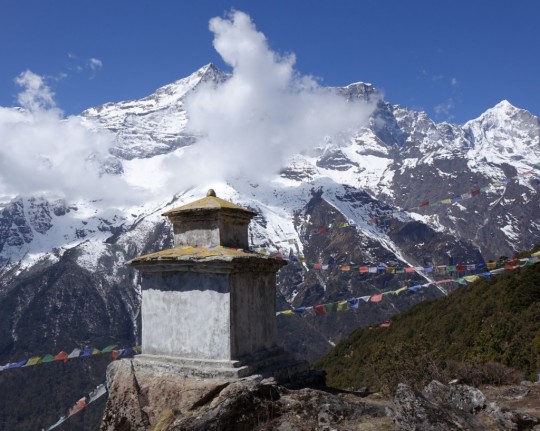
The previous Lawudo Lama’s stupa, a short walk from Lawudo Gompa, Solu Khumbu, Nepal, April 2015. Photo by Ven. Roger Kunsang.
“How can you recover completely from the heavy disease of the disturbing, unsubdued mind, which has been there from beginningless previous lifetimes?” Lama Zopa Rinpoche asked during the 12th Kopan course in 1979. “How can you recover within one month, within seven days or several years? For an ordinary, chronic disease like cancer and T.B. – which the person wasn’t born with – even for those diseases, the person should have treatment for many years, has to be very careful and should have powerful and long treatment.
“To completely make non-existent the disease of the disturbed, unsubdued mind, which has been there from beginningless previous lifetimes, which has no beginning, the treatment, listening to the holy Dharma and practicing the holy Dharma, of course, is extremely worthwhile. It is necessary to have powerful treatment, the powerful Dharma practice, even if it takes hundreds of lifetimes or a hundred eons. Even it if takes that much to take treatment, to completely make non-existent the heavy disease of the delusions, of course, it is extremely important. It is extremely important and it is worthwhile, even though it takes a hundred lifetimes, a hundred eons, which is nothing.
“Even if it takes a hundred eons to completely eradicate, to completely recover from the disease of the delusions and to be free from samsara, even though it takes a hundred eons, that still is very quick, very short if you think how many eons one has been sick with the delusions of the disturbed, unsubdued mind.”
Excerpted from the transcripts of Section Three of the 12th Kopan course (http://bit.ly/12th-kopan-course) made available by the Lama Yeshe Wisdom Archive. Edited by Mandala for inclusion on FPMT.org.
Learn more about Lama Zopa Rinpoche, spiritual director of the Foundation for the Preservation of Mahayana Tradition (FPMT), and Rinpoche’s vision for a better world. Sign up to receive news and updates.
10
Rinpoche’s Pillar Altar
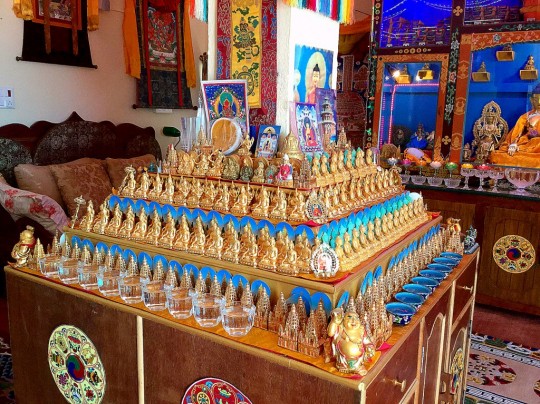
Lama Zopa Rinpoche designed this altar that surrounds a support pillar in his room at Root Institute, Bodhgaya, India, March 2015. Photo by Ven. Sarah Thresher.
“When Rinpoche’s room at Root Institute in Bodhgaya, India, was expanded, a support pillar was left exposed in the middle of the room,” said long-time student Ven. Sarah Thresher, who has been sharing news of Rinpoche’s activities in Bodhgaya. “Rinpoche promptly designed a special altar with levels surrounding all four sides of the pillar that could hold many holy objects and be circumambulated every time anyone walks around the room.
“The finished altar also has the eight auspicious signs all around, offering bowls on each side and cupboards to store incense and other items. Each of the small metal Buddhas is filled with many mantras and blessed. On Rinpoche’s instructions, holes were drilled into the bottom of each golden stupa for the four dharmakaya relic mantras to be inserted. Rinpoche particularly wanted the Stainless Beam mantra [Zung of the Exalted Completely Pure Stainless Light] to be put inside the small stupas since the benefits are so great. The idea is that people can carry these stupas with them as they circumambulate.”
Learn more about Lama Zopa Rinpoche, spiritual director of the Foundation for the Preservation of Mahayana Tradition (FPMT), and Rinpoche’s vision for a better world. Sign up to receive news and updates.
- Tagged: lama zopa rinpoche, root institute, ven. sarah thresher
- 0
9
Lama Zopa Rinpoche Visits Lawudo
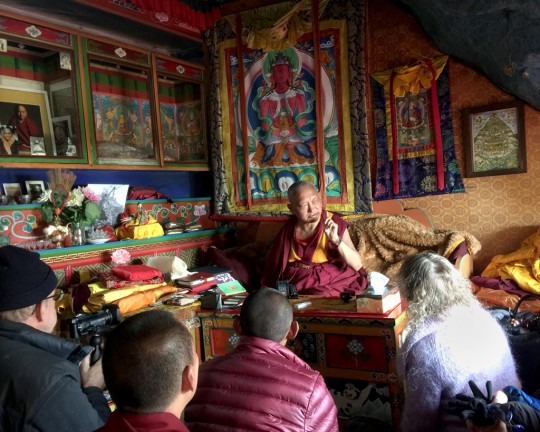
Lama Zopa Rinpoche talking about the previous Lawudo Lama in his meditation cave, Lawudo, Solu Khumbu, Nepal, April 2015. Photo by Ven. Roger Kunsang.
On April 4, Ven. Roger Kunsang shared via Twitter that FPMT spiritual director Lama Zopa Rinpoche was boarding a helicopter bound for Lawudo Gompa and Retreat Centre, located in the mountainous Solu Khumbu region of Nepal. Lawudo is where Rinpoche’s previous incarnation Lawudo Lama Kunsang Yeshe meditated for 20 years, and it is also near to where Rinpoche was born.
Rinpoche’s visit is big news as his last trip to Lawudo was in June 2008. Not only is Rinpoche’s presence there very important to the Sherpa people in the area, Rinpoche is returning to an essential location in FPMT’s history. “Lawudo is the heart where FPMT started,” Rinpoche has said. Online, you can read the story of Rinpoche’s 1998 visit, “The Lawudo Lama Returns,” and other Mandala stories on Lawudo.
In addition to blog posts on FPMT.org, photos of Rinpoche from his visit to Lawudo are being shared over social media and many can be seen by visiting Lama Zopa Rinpoche’s Facebook page.
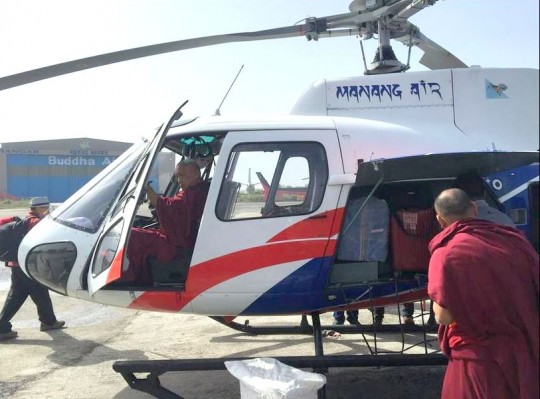
Lama Zopa Rinpoche boarding the helicopter for Lawudo, Nepal, April 2014. Photo by Ven. Roger Kunsang.
More information, photos and updates about FPMT spiritual director Lama Zopa Rinpoche can be found on Rinpoche’s homepage. If you’d like to receive news of Lama Zopa Rinpoche via email, sign up to Lama Zopa Rinpoche News.
- Tagged: lama zopa rinpoche, lawudo, twitter
- 0
8
The Base, the Label and the Mind
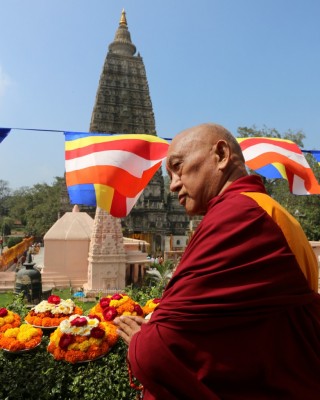
Lama Zopa Rinpoche, Mahabodhi Stupa, Bodhgaya, India, March 2105. Photo by Ven. Thubten Kunsang.
During the 25th Kopan course in 1992 Lama Zopa Rinpoche gave a concise explanation of dependent arising, the way in which things exist:
Lama Tsongkhapa says, “By seeing the meaning of the dependent arising, emptiness, it stops the root of all the samsaric beings’ sufferings, ignorance, concept of true existence.” Whatever exists – hell, enlightenment, samsara, nirvana, I, action, object, everything – whatever exists, all these are dependent arising. By depending on the base, the mind which labels and the label, depending on these things, then the I exists, the action exists, the object exists, hell exists, enlightenment exists, samsara exists, nirvana exists, impermanent phenomena, permanent phenomena, all these things exist. All these things exist. So, depending on these three – base, mind, label – depending on these things then it exists. Depending on these things, all these things exist or arise.
Excerpted from the transcripts of the 25th Kopan course (http://bit.ly/25th-kopan-course) made available by the Lama Yeshe Wisdom Archive. Lightly edited by Mandala for inclusion on FPMT.org.
Learn more about Lama Zopa Rinpoche, spiritual director of the Foundation for the Preservation of Mahayana Tradition (FPMT), and Rinpoche’s vision for a better world. Sign up to receive news and updates.
- Tagged: dependent arising, emptiness, kopan course, lama zopa rinpoche
- 0
7
Lama Zopa Rinpoche at Root Institute [Video]
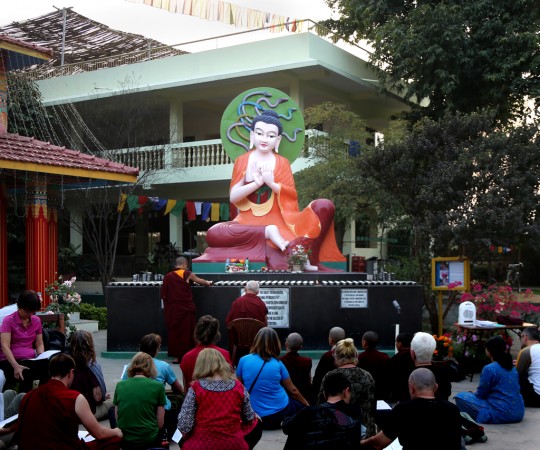
Lama Zopa Rinpoche in front of the Nagarjuna statue at Root Institute, Bodhgaya, India, February 2015.
While staying at Root Institute in Bodhgaya, India, Lama Zopa Rinpoche explained a verse from Lama Chöpa that he had written out to be put in front of the large Nagarjuna statue at the center. The verse Rinpoche wrote out is as follows:
Samsara and Nirvana lack even an atom of inherent existence
And cause and effect and dependent arising are infallible
I seek your blessings to discern the meaning of Nagarjuna’s thought —
That these two are mutually complementary and not contradictory.*
WATCH: Video of Lama Zopa Rinpoche speaking on a verse from Lama Chöpa
FPMT Education Services has created many resources to enrich your practice of Lama Chöpa, including a new webpage with videos of Rinpoche chanting the tunes. You can also read Rinpoche’s commentary on this important practice.
*Lama Chöpa verse 108, published by FPMT Education Services, 2013
More information, photos and updates about FPMT spiritual director Lama Zopa Rinpoche can be found on Rinpoche’s webpage. If you’d like to receive news of Lama Zopa Rinpoche via email, sign up to Lama Zopa Rinpoche News.
- Tagged: bodhgaya, lama chopa, lama zopa rinpoche, nagarjuna statue, video
- 0
6
Lama Zopa Rinpoche Arrives at Kopan Monastery
After spending several months in India, FPMT spiritual director Lama Zopa Rinpoche returned to Kopan Monastery in Nepal on April 1. A few days later, Rinpoche traveled to Lawudo Gompa and Retreat Centre in the mountainous Solu Khumbu region of Nepal. Lawudo is where Rinpoche’s previous incarnation Lawudo Lama Kunsang Yeshe meditated.
In May, Rinpoche begins a teaching tour that spans New Zealand, Australia, Russia, the Netherlands and Latin America. For details on teachings events with Rinpoche, visit Rinpoche’s schedule page on FPMT.org.
Learn more about Lama Zopa Rinpoche, spiritual director of the Foundation for the Preservation of Mahayana Tradition (FPMT), and Rinpoche’s vision for a better world. Sign up to receive news and updates.
- Tagged: kopan monastery, lama zopa rinpoche
- 0
3
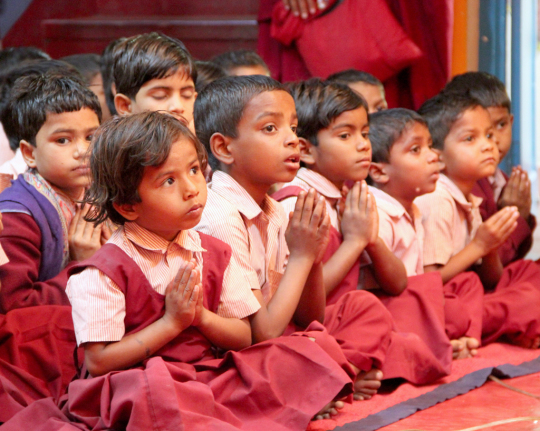
Students of Maitreya School listening to Lama Zopa Rinpoche, Root Institute, Bodhgaya, India, March 2015. Photo by Ven. Roger Kunsang.
In March 2015, Lama Zopa Rinpoche dictated this letter to the students of Maitreya School, Root Institute’s free school benefiting local impoverished children in Bodhgaya, India. Rinpoche wrote the letter after the school master explained that the main problem the children faced was parents drinking and fighting. Rinpoche asked that this letter be translated into Hindi, framed, put on the wall, and read and explained often to the students.
My most dear, precious, kind, wish-fulfilling children,
I understand the so-much suffering and problems at home: parents that drink so much alcohol without control and then fight all the time. That makes you all so sad. It can be also very, very scary. And it is not just one time, two times, three times; it is often. It might be like that for you.
Their problem is not only that they don’t have external, outside-world, general-world education, but that they don’t have inner education. The Sanskrit word for this is “Dharma.” And not just understanding Dharma, but practice and attainment, especially the attainments of patience, contentment, compassion and so forth. They do not have these qualities. They didn’t get to achieve these qualities and that’s because they never learned, because nobody explained.
We can see with the eyes their life problems – so much suffering and no happiness. This is a very good example for us. As you are young, you have to grow up in a positive way, not a negative way. It is so much suffering for them, but for you, seeing their life – the unbelievable suffering, fear and chaos – is great education. For you, it is great inspiration not to live your life like them. If you live life like them, soon you will grow up and will have to have a family; you will have children and so your life will be unbelievable suffering – fighting like them and drinking alcohol. Having a family is supposed to be a happiness, but with life so uncontrolled, there’s much fighting, sadness, fear, and so many other negative things. There are even things couples don’t have to fight about, but because of drinking, even if there is not so much reason to fight, they find small reasons to fight about and harm each other. All this happens every day. Not only you the wife or you the husband suffer, but it also bring so much suffering to your family, your children. Your life will become like this or worse.
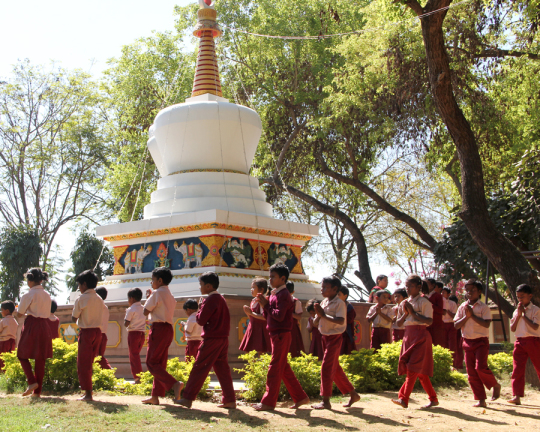
Students circumambulating the stupa at Maitreya School, Root Institute, Bodhgaya, India, March 2015. Photo by Ven. Roger Kunsang.
Therefore, your life is in your hands; it’s up to your mind. If you develop compassion for others and wisdom, especially Dharma wisdom – inner wisdom, inner education – then as much as you develop those, you will have so much happiness. Even though your parents suffered so much, you will grow up with so much happiness. When you have a family and children, you will all have so much happiness. You won’t bring suffering to your family. By developing compassion to others and wisdom, this inner wisdom, you will bring so much happiness to yourself, your husband, your wife, your children. Then, your children will become a great example to their children. They will know what brings suffering, so they will not bring suffering to their children; they will bring happiness. Each generation becomes a great example of how to bring peace and happiness.
I want Maitreya School to help to bring peace and happiness, to bring wisdom light to life, not bring darkness, but to bring the sun – wisdom light – and as a result, bring peace and happiness. That is my real aim for the school. It is not just school. Even in the Western world there are kindergartens, colleges, universities where you can learn so many things, but the mind never changes. The mind, which produces happiness and suffering, never changes; and the mind is used only to produce suffering, not to produce happiness. That happens because developing compassion, the good heart and wisdom is limited.
Even though you are children, it is so important to practice kindness day and night, not to harm others, and on top of that, to benefit others. Even if you can’t benefit, at least pray and dedicate your merits for others to have happiness, harmony and the success of their wishes according to Dharma. This way, nothing becomes negative karma, negative action, but instead it becomes the cause of peerless happiness, total cessation of obscurations, and the completion of realizations.
Try, beginning in childhood, to practice the good heart, to be kind to others – and not only to people, but even to insects and animals. This way, you become a good human being by not harming others and only bringing greater and greater peace and happiness not only to yourself, but also to your family, society, country, and world. And you bring the same to the six types of living beings – hell beings, hungry ghosts, animals, human beings, suras, asuras – and intermediate state beings. Not only do you bring temporary happiness, but you bring ultimate happiness, like the sun shining. Show respect; treat others like yourself or more important than yourself. Of course, you need compassion and wisdom, otherwise, even if others have eyes, you make them blind – in other words, you cause suffering to others.
Thank you very much, with much love and prayer.
My sincere advice is to pray to His Holiness the Dalai Lama. He is Buddha in an ordinary human form that appears to us. Pray from the heart that your parents have peace, harmony, and no more fighting. Pray that they get Dharma happiness, the peerless happiness, cessation of obscurations, and the completion of all the realizations. Even praying sincerely to His Holiness can help. Don’t just pray only one time, no, pray every day. You need to pray all the time.
Transcribed by Ven. Sarah Thresher, Root Institute, March 2015. Edited by Mandala for inclusion on FPMT.org
Learn more about Lama Zopa Rinpoche, spiritual director of the Foundation for the Preservation of Mahayana Tradition (FPMT), and Rinpoche’s vision for a better world. Sign up to receive news and updates.
2

Lama Zopa Rinpoche making a request to His Holiness the Dalai Lama during the Jangchup Lamrim teachings, South India, December 2014. Photo by Bill Kane.
In early 2014, Lama Zopa Rinpoche translated this special quote from the Stainless Sky Sutra into English:
“Ananda, the Tathagatas do not appear to the sentient beings, but the virtuous friend completely appears and reveals the Dharma and plants the seed of liberation; because of that, cherish the virtuous friend as more special than the Tathagatas.”
Scribed by Ven. Sarah Thresher, Root Institute, Bodhgaya, India, February 19, 2014.
Lama Zopa Rinpoche is the spiritual director of the Foundation for the Preservation of Mahayana Tradition (FPMT), a Tibetan Buddhist organization dedicated to the transmission of the Mahayana Buddhist tradition and values worldwide through teaching, meditation and community service.
- Tagged: advice from lama zopa rinpoche
- 0
1
Auspicious Nectar Rain
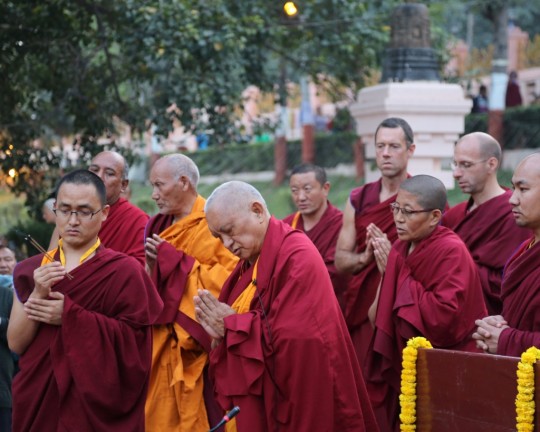
Lama Zopa Rinpoche at the Mahabodhi Stupa in Bodhgaya, India, February 2015. Photo by Ven. Thubten Kunsang.
“March 27 was Rinpoche’s final night in Bodhgaya and so we went to the stupa to offer robes to the Buddha at the Mahabodhi Stupa,” said Ven. Sarah Thresher, who has been sharing news about Lama Zopa Rinpoche beneficial activities in Bodhgaya over the last two months. “After offering flowers, incense and music and circumambulating the stupa once, Rinpoche went to the inner shrine to make prayers in front of the main Buddha image. Robes were offered along with five-color silk khatas and bowls filled with food.
“The stupa was already closed by the time we left the shrine (it closes at 9 p.m.) but instead of walking to the exit as we usually do, Rinpoche very deliberately walked to the Bodhi tree and sat down to pray, instructing the Westerners to read the dedication prayer from the Chöd in English and then chant the Tibetan, while the monks read the prayer of the path of Guhyasamaja. No sooner did we start the prayers than a strange mist-like vapor seemed to fall from the tree, which gradually turned into a very delicate rain.
“Rinpoche has been in Bodhgaya for two months now and tonight was the culmination of a constant stream of prayers, practices, teachings and blessings. A week ago, a Nyingma meditator commented to me how important it was that Rinpoche was in Bodhgaya: ‘This is one of the holiest places in the world,’ he said, ‘the blessings and presence of high lamas like Rinpoche keep it that way.’
“After finishing the prayers we left the stupa and Rinpoche once again patiently, respectfully and generously made charity to each of the beggars. Before getting into the car to leave, Rinpoche mentioned the ‘nectar that fell from the Bodhi tree’ as the final prayers were being made was ‘a good sign’ and ‘auspicious.'”
Lama Zopa Rinpoche is the spiritual director of the Foundation for the Preservation of Mahayana Tradition (FPMT), a Tibetan Buddhist organization dedicated to the transmission of the Mahayana Buddhist tradition and values worldwide through teaching, meditation and community service.
- Tagged: bodhgaya, lama zopa rinpoche, ven. sarah thresher
- 0
- Home
- News/Media
- Study & Practice
- About FPMT Education Services
- Latest News
- Programs
- New to Buddhism?
- Buddhist Mind Science: Activating Your Potential
- Heart Advice for Death and Dying
- Discovering Buddhism
- Living in the Path
- Exploring Buddhism
- FPMT Basic Program
- FPMT Masters Program
- FPMT In-Depth Meditation Training
- Maitripa College
- Lotsawa Rinchen Zangpo Translator Program
- Universal Education for Compassion & Wisdom
- Online Learning Center
- Prayers & Practice Materials
- Overview of Prayers & Practices
- Full Catalogue of Prayers & Practice Materials
- Explore Popular Topics
- Benefiting Animals
- Chenrezig Resources
- Death & Dying Resources
- Lama Chopa (Guru Puja)
- Lama Zopa Rinpoche: Compendium of Precious Instructions
- Lama Zopa Rinpoche: Life Practice Advice
- Lama Zopa Rinpoche Practice Series
- Lamrim Resources
- Mantras
- Prayer Book Updates
- Purification Practices
- Sutras
- Thought Transformation (Lojong)
- Audio Materials
- Dharma Dates – Tibetan Calendar
- Translation Services
- Publishing Services
- Teachings and Advice
- Find Teachings and Advice
- Lama Zopa Rinpoche Advice Page
- Lama Zopa Rinpoche: Compendium of Precious Instructions
- Lama Zopa Rinpoche Video Teachings
- ༧སྐྱབས་རྗེ་བཟོད་པ་རིན་པོ་ཆེ་མཆོག་ནས་སྩལ་བའི་བཀའ་སློབ་བརྙན་འཕྲིན།
- Podcasts
- Lama Yeshe Wisdom Archive
- Buddhism FAQ
- Dharma for Young People
- Resources on Holy Objects
- Ways to Offer Support
- Centers
- Affiliates Area
- Teachers
- Projects
- Charitable Projects
- Make a Donation
- Applying for Grants
- News about Projects
- Other Projects within FPMT
- Support International Office
- Projects Photo Galleries
- Give Where Most Needed
- FPMT
- Shop
Translate*
*powered by Google TranslateTranslation of pages on fpmt.org is performed by Google Translate, a third party service which FPMT has no control over. The service provides automated computer translations that are only an approximation of the websites' original content. The translations should not be considered exact and only used as a rough guide.Basically, the human mind is mostly unconscious, ignorant, and gets so preoccupied with new experiences, that it forgets the old ones. Review the past month: exactly what happened, precisely what feelings did you have, every day? You can’t remember, can you? But if you practice this slowly, slowly, continuously checking within your mind, eventually, you’ll be able to remember more and more of your previous experiences.







